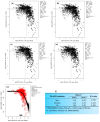Is Chronic Kidney Disease Due to Cadmium Exposure Inevitable and Can It Be Reversed?
- PMID: 38672074
- PMCID: PMC11048639
- DOI: 10.3390/biomedicines12040718
Is Chronic Kidney Disease Due to Cadmium Exposure Inevitable and Can It Be Reversed?
Abstract
Cadmium (Cd) is a metal with no nutritional value or physiological role. However, it is found in the body of most people because it is a contaminant of nearly all food types and is readily absorbed. The body burden of Cd is determined principally by its intestinal absorption rate as there is no mechanism for its elimination. Most acquired Cd accumulates within the kidney tubular cells, where its levels increase through to the age of 50 years but decline thereafter due to its release into the urine as the injured tubular cells die. This is associated with progressive kidney disease, which is signified by a sustained decline in the estimated glomerular filtration rate (eGFR) and albuminuria. Generally, reductions in eGFR after Cd exposure are irreversible, and are likely to decline further towards kidney failure if exposure persists. There is no evidence that the elimination of current environmental exposure can reverse these effects and no theoretical reason to believe that such a reversal is possible. This review aims to provide an update on urinary and blood Cd levels that were found to be associated with GFR loss and albuminuria in the general populations. A special emphasis is placed on the mechanisms underlying albumin excretion in Cd-exposed persons, and for an accurate measure of the doses-response relationships between Cd exposure and eGFR, its excretion rate must be normalised to creatinine clearance. The difficult challenge of establishing realistic Cd exposure guidelines such that human health is protected, is discussed.
Keywords: GFR; albuminuria; cadmium; chronic kidney disease; health risk; protein reabsorption; β2-microglobulin.
Conflict of interest statement
The author declares no conflicts of interest.
Figures




Similar articles
-
Chronic Kidney Disease Induced by Cadmium and Diabetes: A Quantitative Case-Control Study.Int J Mol Sci. 2023 May 20;24(10):9050. doi: 10.3390/ijms24109050. Int J Mol Sci. 2023. PMID: 37240395 Free PMC article.
-
The inverse association of glomerular function and urinary β2-MG excretion and its implications for cadmium health risk assessment.Environ Res. 2019 Jun;173:40-47. doi: 10.1016/j.envres.2019.03.026. Epub 2019 Mar 14. Environ Res. 2019. PMID: 30889420
-
Estimation of the Cadmium Nephrotoxicity Threshold from Loss of Glomerular Filtration Rate and Albuminuria.Toxics. 2023 Sep 6;11(9):755. doi: 10.3390/toxics11090755. Toxics. 2023. PMID: 37755765 Free PMC article.
-
Estimation of health risks associated with dietary cadmium exposure.Arch Toxicol. 2023 Feb;97(2):329-358. doi: 10.1007/s00204-022-03432-w. Epub 2023 Jan 2. Arch Toxicol. 2023. PMID: 36592197 Review.
-
Usefulness of biomarkers of exposure to inorganic mercury, lead, or cadmium in controlling occupational and environmental risks of nephrotoxicity.Ren Fail. 1999 May-Jul;21(3-4):251-62. doi: 10.3109/08860229909085087. Ren Fail. 1999. PMID: 10416202 Review.
Cited by
-
Disentangling the role of selenium in antagonizing the toxicity of arsenic and cadmium.Arch Toxicol. 2025 Feb;99(2):513-540. doi: 10.1007/s00204-024-03918-9. Epub 2025 Jan 8. Arch Toxicol. 2025. PMID: 39776200 Review.
-
Geophagia among pregnant women: evaluating the microbiological and toxicological safety of calabash chalk and its implications on maternal health.Environ Geochem Health. 2025 Jul 30;47(9):347. doi: 10.1007/s10653-025-02656-w. Environ Geochem Health. 2025. PMID: 40736606 Free PMC article. Review.
-
Enhancing renal protection against cadmium toxicity: the role of herbal active ingredients.Toxicol Res (Camb). 2024 Dec 21;13(6):tfae222. doi: 10.1093/toxres/tfae222. eCollection 2024 Dec. Toxicol Res (Camb). 2024. PMID: 39712642 Review.
-
Modulation of Adverse Health Effects of Environmental Cadmium Exposure by Zinc and Its Transporters.Biomolecules. 2024 May 31;14(6):650. doi: 10.3390/biom14060650. Biomolecules. 2024. PMID: 38927054 Free PMC article. Review.
-
Hepatorenal protective effects of essential oils against chemical overexposure induced oxidative damage.Front Pharmacol. 2025 Apr 16;16:1580805. doi: 10.3389/fphar.2025.1580805. eCollection 2025. Front Pharmacol. 2025. PMID: 40308777 Free PMC article. Review.
References
-
- Murton M., Goff-Leggett D., Bobrowska A., Garcia Sanchez J.J., James G., Wittbrodt E., Nolan S., Sörstadius E., Pecoits-Filho R., Tuttle K. Burden of chronic kidney disease by KDIGO categories of glomerular filtration rate and albuminuria: A Systematic review. Adv. Ther. 2021;38:180–200. doi: 10.1007/s12325-020-01568-8. - DOI - PMC - PubMed
-
- Foreman K.J., Marquez N., Dolgert A., Fukutaki K., Fullman N., McGaughey M., Pletcher M.A., Smith A.E., Tang K., Yuan C.W., et al. Forecasting life expectancy, years of life lost, and all-cause and cause-specific mortality for 250 causes of death: Reference and alternative scenarios for 2016-40 for 195 countries and territories. Lancet. 2018;392:2052–2090. doi: 10.1016/S0140-6736(18)31694-5. - DOI - PMC - PubMed
Publication types
LinkOut - more resources
Full Text Sources
Research Materials
Miscellaneous

